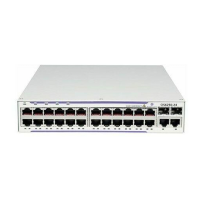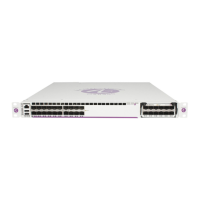QoS Overview
Page 70 7210 SAS D, E, K OS Quality of Service Guide
Tuning the Shared Buffer Utilization Calculation
NOTE: This is not supported on 7210 SAS-E and 7210 SAS-K.
The 7210 SAS-D allows tuning the calculation of the Shared Buffer Average Utilization (SBAU)
after assigning buffers for a packet entering a queue as used by the RED slopes to calculate a
packet’s drop probability. The 7210 SAS-D implements a time average factor (TAF) parameter in
the buffer policy which determines the contribution of the historical shared buffer utilization and
the instantaneous Shared Buffer Utilization (SBU) in calculating the SBAU. The TAF defines a
weighting exponent used to determine the portion of the shared buffer instantaneous utilization
and the previous shared buffer average utilization used to calculate the new shared buffer average
utilization. To derive the new shared buffer average utilization, the buffer pool takes a portion of
the previous shared buffer average and adds it to the inverse portion of the instantaneous shared
buffer utilization (SBU). The formula used to calculated the average shared buffer utilization is:
where:
SBAUn = Shared buffer average utilization for event n
SBAUn-1 = Shared buffer average utilization for event (n-1)
SBU = The instantaneous shared buffer utilization
TAF = The time average factor
Figure 25 shows the effect the allowed values of TAF have on the relative weighting of the
instantaneous SBU and the previous SBAU (SBAUn-1) has on the calculating the current SBAU
(SBAUn).
Table 25: TAF Impact on Shared Buffer Average Utilization Calculation
TAF
2
TAF
Equates
To
Shared Buffer
Instantaneous
Utilization Portion
Shared Buffer Average
Utilization Portion
0
2
0
1 1/1 (1) 0 (0)
1
2
1
2 1/2 (0.5) 1/2 (0.5)
2
2
2
4 1/4 (0.25) 3/4 (0.75)
SBAU
n
SBU
1
2
TAF
------------
×
SBAU
n 1–
2
TAF
1–
2
TAF
---------------------
×
+=

